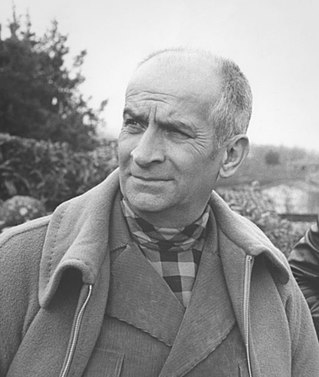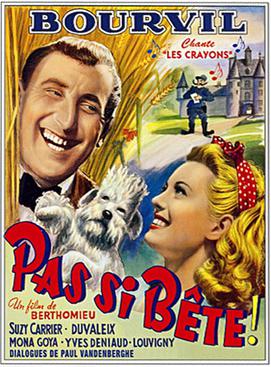
The Lumière brothers, Auguste Marie Louis Nicolas Lumière and Louis Jean Lumière, were French manufacturers of photography equipment, best known for their Cinématographe motion picture system and the short films they produced between 1895 and 1905, which places them among the earliest filmmakers.

The comedy film is a film genre that emphasizes humor. These films are designed to amuse audiences and make them laugh. Films in this genre typically have a happy ending, with dark comedy being an exception to this rule. Comedy is one of the oldest genres in film, and it is derived from classical comedy in theatre. Some of the earliest silent films were slapstick comedies, which often relied on visual depictions, such as sight gags and pratfalls, so they could be enjoyed without requiring sound. To provide drama and excitement to silent movies, live music was played in sync with the action on the screen, on pianos, organs, and other instruments. When sound films became more prevalent during the 1920s, comedy films grew in popularity, as laughter could result from both burlesque situations but also from humorous dialogue.

The cinema of France comprises the film industry and its film productions, whether made within the nation of France or by French film production companies abroad. It is the oldest and largest precursor of national cinemas in Europe, with primary influence also on the creation of national cinemas in Asia.

Fernand Joseph Désiré Contandin, better known as Fernandel, was a French comic actor. Born in Marseille, France, to Désirée Bedouin and Denis Contandin, originating in Perosa Argentina, a town located in the province of Turin, Italy, he became a comedy star, first gaining popularity in French vaudeville, operettas, and music-hall revues. His stage name originated from his marriage to Henriette Manse, the sister of his best friend and frequent cinematic collaborator Jean Manse. So attentive was he to his wife that his mother-in-law amusingly referred to him as Fernand d'elle.
Comedy drama is a hybrid genre of works that combine elements of comedy and drama. In film, as well as scripted television series, serious dramatic subjects are dealt with realism and subtlety, while preserving a humorous tenor.

Charles-Émile Reynaud was a French inventor, responsible for the praxinoscope and was responsible for the first projected animated films. His Pantomimes Lumineuses premiered on 28 October 1892 in Paris. His Théâtre Optique film system, patented in 1888, is also notable as the first known instance of film perforations being used. The performances predated Auguste and Louis Lumière's first paid public screening of the cinematographe on 26 December 1895, often seen as the birth of cinema.

Louis Germain David de Funès de Galarza was a French actor and comedian. He is France's favourite actor, according to a series of polls conducted since the late 1960s, having played over 150 roles in film and over 100 on stage. His acting style is remembered for its high-energy performance and his wide range of facial expressions and tics. A considerable part of his best-known acting was directed by Jean Girault.

A double act is a form of comedy originating in the British music hall tradition, and American vaudeville, in which two comedians perform together as a single act, often highlighting differences in their characters' personalities. Pairings are typically long-term, in some cases for the artists' entire careers. Double acts perform on the stage, television and film.

Silent comedy is a style of film, related to but distinct from mime, developed to bring comedy into the medium of film during the silent film era (1900s–1920s), before synchronized soundtracks that could include dialogue were technologically available for the majority of films. While silent comedy is still practiced today, albeit much less frequently, it has significantly influenced modern comedic media.
Mo lei tau is a type of slapstick humour associated with Hong Kong popular culture that developed during the late 20th century. It is a phenomenon that has grown largely from its presentation in modern film media. Its humour arises from the placement of surprising and incongruous elements, and the complex interplay of cultural subtleties. Typical constituents of this humour include nonsensical parodies, juxtaposition of contrasts, sudden surprises in spoken dialogue and action and improbable and deliberate anachronisms.

In comedy, a visual gag or sight gag is anything which conveys its humour visually, often without words being used at all. The gag may involve a physical impossibility or an unexpected occurrence. The humor is caused by alternative interpretations of the goings-on. Visual gags are used in magic, plays, and acting on television or movies.

Albert Willemetz was a French librettist.

L'Arroseur Arrosé is an 1895 French short black-and-white silent comedy film directed and produced by Louis Lumière and starring François Clerc and Benoît Duval. It was first screened on June 10, 1895.

Commedia all'italiana, or Italian-style comedy, is an Italian film genre born in Italy in the 1950s and developed in the 1960s and 1970s. It is widely considered to have started with Mario Monicelli's Big Deal on Madonna Street in 1958, and derives its name from the title of Pietro Germi's Divorce Italian Style (1961). According to most of the critics, La Terrazza (1980) by Ettore Scola is the last work considered part of the commedia all'italiana.

Jean-Pierre Mocky, pseudonym of Jean-Paul Adam Mokiejewski, was a French film director, actor, screenwriter and producer.
Comedy is a genre that consists of discourses or works intended to be humorous or amusing by inducing laughter, especially in theatre, film, stand-up comedy, television, radio, books, or any other entertainment medium. The term originated in ancient Greece: In Athenian democracy, the public opinion of voters was influenced by political satire performed by comic poets in theaters. The theatrical genre of Greek comedy can be described as a dramatic performance pitting two groups, ages, genders, or societies against each other in an amusing agon or conflict. Northrop Frye depicted these two opposing sides as a "Society of Youth" and a "Society of the Old". A revised view characterizes the essential agon of comedy as a struggle between a relatively powerless youth and the societal conventions posing obstacles to his hopes. In this struggle, the youth then becomes constrained by his lack of social authority, and is left with little choice but to resort to ruses which engender dramatic irony, which provokes laughter.
American comedy films are comedy films produced in the United States. The genre is one of the oldest in American cinema; some of the first silent movies were comedies, as slapstick comedy often relies on visual depictions, without requiring sound. With the advent of sound in the late 1920s and 1930s, comedic dialogue rose in prominence in the work of film comedians such as W. C. Fields and the Marx Brothers. By the 1950s, the television industry had become serious competition for the movie industry. The 1960s saw an increasing number of broad, star-packed comedies. In the 1970s, black comedies were popular. Leading figures in the 1970s were Woody Allen and Mel Brooks. One of the major developments of the 1990s was the re-emergence of the romantic comedy film. Another development was the increasing use of "gross-out humour".

Not So Stupid is a 1946 French comedy film directed by André Berthomieu and starring Bourvil, Suzy Carrier and Bernard Lancret. In 1928 Berthomieu had made a silent film of the same name. This was Bourvil's first film; originally a musician and singer, he went on to become one of the great comic actors of French cinema.
Louis Alfred Doumet, known by his stage name of Doumel, was a French actor and comedian active in the inter-war years.
The Prix Courteline is a French prize rewarding cinematic humour, named in tribute to Georges Courteline (1858-1929). It was founded in 1930 by Roland Dorgelès. It was originally awarded every two years.















